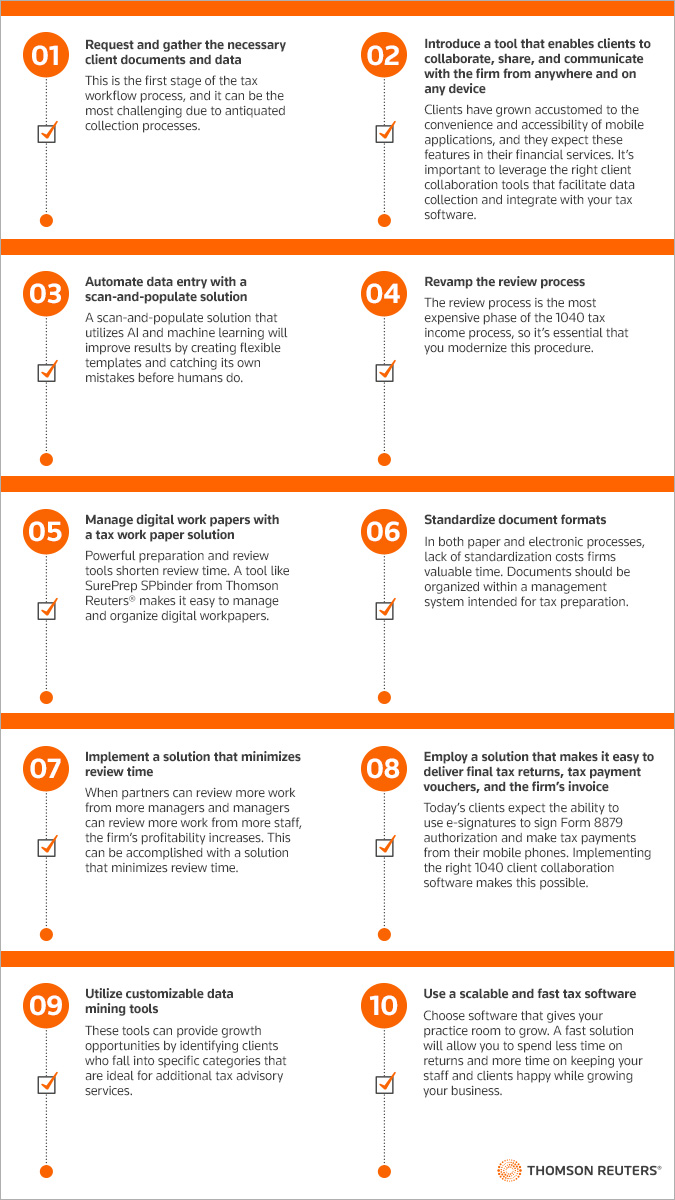Top 10 tips to streamline your 1040 tax workflow
Tax season is infamous among tax and accounting professionals for its long hours and heavy workload—pains worsened by inefficiencies in your tax workflow.
These inefficiencies put a strain on your existing staff, cost your practice money, and may put you at a competitive disadvantage in attracting and retaining top talent.
But these inefficiencies are fixable thanks to advancements in technology that are making it easier than ever for tax professionals to access the tools to revamp their workflows and eliminate these frustrating inefficiencies.
Use this checklist to get started on the path to a seamless 1040 tax workflow and the opportunities that come with it.
1. Request and gather the necessary client documents and data This is the first stage of the tax workflow process, and it can be the most challenging due to antiquated collection processes. 2. Introduce a tool that enables clients to collaborate, share, and communicate with the firm from anywhere and on any device Clients have grown accustomed to the convenience and accessibility of mobile applications, and they expect these features in their financial services. It’s important to leverage the right client collaboration tools that facilitate data collection and integrate with your tax software. 3. Automate data entry with a scan-and-populate solution A scan-and-populate solution that utilizes AI and machine learning will improve results by creating flexible templates and catching its own mistakes before humans do. 4. Revamp the review process The review process is the most expensive phase of the 1040 tax income process, so it’s essential that you modernize this procedure. 5. Manage digital workpapers with a tax work paper solution Powerful preparation and review tools shorten review time. A tool like SurePrep SPbinder makes it easy to manage and organize digital workpapers. 6. Standardize document formats In both paper and electronic processes, lack of standardization costs firms valuable time. Documents should be organized within a management system intended for tax preparation. 7. Implement a solution that minimizes review time When partners can review more work from more managers and managers can review more work from more staff, the firm’s profitability increases. This can be accomplished with a solution that minimizes review time. 8. Employ a solution that makes it easy to deliver final tax returns, tax payment vouchers, and the firm’s invoice Today’s clients expect the ability to use e-signatures to sign Form 8879 authorization and make tax payments from their mobile phones. Implementing the right 1040 client collaboration software makes this possible. 9. Utilize customizable data mining tools These tools can provide growth opportunities by identifying clients who fall into specific categories that are ideal for additional tax advisory services. 10. Use scalable and fast tax software Choose software that gives your practice room to grow. A fast solution will allow you to spend less time on returns and more time on keeping your staff and clients happy while growing your business.
Tax season can be a stressful and hectic time for both tax professionals and their clients.
However, by leveraging the right tools and strategies, you can turn it into an opportunity to strengthen your relationships, increase your efficiency, and grow your firm.
By using data analytics, client portals, and scalable tax software, you can provide more value to your clients, streamline your workflows, and stand out from the competition.
Interested in learning more about streamlining your 1040 workflows? Download and read our white paper below:
White PaperFind your flow: 1040 tax workflow best practices By the end of this white paper, you’ll learn how an efficient tax practice can:
|
|







